Trevi Fountain
The Trevi Fountain (Italian: Fontana di Trevi) is a fountain in the Trevi district in Rome, Italy, designed by Italian architect Nicola Salvi and completed by Giuseppe Pannini and several others. Standing 26.3 metres (86 ft) high and 49.15 metres (161.3 ft) wide,[1] it is the largest Baroque fountain in the city and one of the most famous fountains in the world. The fountain has appeared in several notable films, including Roman Holiday, Federico Fellini's La Dolce Vita, the eponymous Three Coins in the Fountain, and The Lizzie McGuire Movie.[2]
| Trevi Fountain | |
|---|---|
| Italian: Fontana di Trevi | |
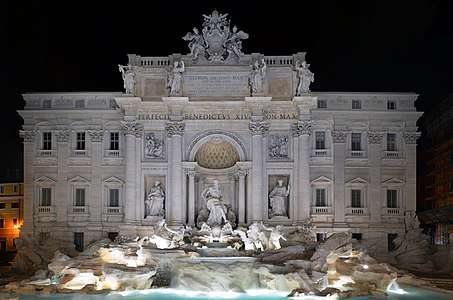 | |
| Artist | Nicola Salvi |
| Year | 1762 |
| Type | Public fountain |
| Medium | Stone |
| Dimensions | 26.3 m × 49.15 m (86 ft × 161.3 ft) |
| Location | Trevi, Rome, Italy |
| 41°54′3″N 12°28′59″E | |
History before 1629
The fountain at the junction of three roads (tre vie)[3] marks the terminal point[4] of the "modern" Acqua Vergine, the revived Aqua Virgo, one of the aqueducts that supplied water to ancient Rome. In 19 BC, supposedly with the help of a virgin, Roman technicians located a source of pure water some 13 km (8.1 mi) from the city. (This scene is presented on the present fountain's façade.) However, the eventual indirect route of the aqueduct made its length some 22 km (14 mi). This Aqua Virgo led the water into the Baths of Agrippa. It served Rome for more than 400 years.[5]
Commission, construction, and design
In 1629, Pope Urban VIII, finding the earlier fountain insufficiently dramatic, asked Gian Lorenzo Bernini to sketch possible renovations, but the project was abandoned when the pope died. Though Bernini's project was never constructed, there are many Bernini touches in the fountain as it exists today. An early, influential model by Pietro da Cortona, preserved in the Albertina, Vienna, also exists, as do various early 18th century sketches, most unsigned, as well as a project attributed to Nicola Michetti[6] one attributed to Ferdinando Fuga[7] and a French design by Edmé Bouchardon.[5]
Competitions had become popular during the Baroque era to design buildings, fountains, as well as the Spanish Steps. In 1730, Pope Clement XII organized a contest in which Nicola Salvi initially lost to Alessandro Galilei – but due to the outcry in Rome over a Florentine having won, Salvi was awarded the commission anyway.[8] Work began in 1732.
Salvi died in 1751 with his work half finished, but he had made sure a barber's unsightly sign would not spoil the ensemble, hiding it behind a sculpted vase,[9] called by Romans the asso di coppe, the "Ace of Cups", because of its resemblance to a Tarot card.[10] Four different sculptors were hired to complete the fountain's decorations: Pietro Bracci (whose statue of Oceanus sits in the central niche), Filippo della Valle, Giovanni Grossi, and Andrea Bergondi.[11] Giuseppe Pannini was hired as architect.[12]
The Trevi Fountain was finished in 1762 by Pannini, who substituted the present allegories for planned sculptures of Agrippa and Trivia, the Roman virgin.[13] It was officially opened and inaugurated on 22 May by Pope Clement XIII.[14]
The majority of the piece is made from Travertine stone, quarried near Tivoli, about 35 kilometres (22 miles) east of Rome.[15]
Restoration
The fountain was refurbished once in 1988 to remove discoloration caused by smog,[16] and again in 1998; the stonework was scrubbed and all cracks and other areas of deterioration were repaired by skilled artisans, and the fountain was equipped with recirculating pumps.[17]
In January 2013, it was announced that the Italian fashion company Fendi would sponsor a 20-month, 2.2-million-euro restoration of the fountain; it was to be the most thorough restoration in the fountain's history.[18]
Restoration work began in June 2014 and was completed in November 2015. The fountain was reopened with an official ceremony on the evening of 3 November 2015. The restoration included the installation of more than 100 LED lights to improve the nighttime illumination of the fountain.[19][20][21]
Iconography
The backdrop for the fountain is the Palazzo Poli, given a new façade with a giant order of Corinthian pilasters that link the two main stories.[22] Taming of the waters is the theme of the gigantic scheme that tumbles forward, mixing water and rockwork, and filling the small square. Tritons guide Oceanus' shell chariot, taming hippocamps.[23]
In the centre, a robustly-modelled triumphal arch is superimposed on the palazzo façade. The centre niche or exedra framing Oceanus has free-standing columns for maximal light and shade. In the niches flanking Oceanus, Abundance spills water from her urn and Salubrity holds a cup from which a snake drinks. Above, bas reliefs illustrate the Roman origin of the aqueducts.[24]
The Tritons and horses provide symmetrical balance, with the maximum contrast in their mood and poses (by 1730, rococo was already in full bloom in France and Germany).
Coin throwing
Coins are purportedly meant to be thrown using the right hand over the left shoulder.[25] This was the theme of 1954's Three Coins in the Fountain and the Academy Award-winning song by that name which introduced the picture.
An estimated 3,000 euros are thrown into the fountain each day.[26] In 2016, an estimated €1.4 million (US$1.5 million) was thrown into the fountain.[27] The money has been used to subsidize a supermarket for Rome's needy;[26] however, there are regular attempts to steal coins from the fountain, even though it is illegal to do so.[26][28][29]
Gallery
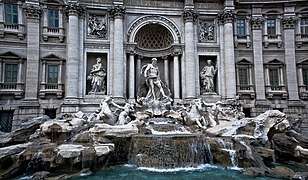 Trevi Fountain
Trevi Fountain Trevi Fountain in the evening
Trevi Fountain in the evening- Sculptures at night
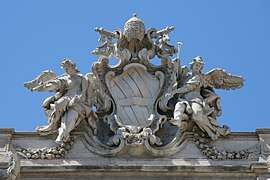 Trevi Fountain papal coat of arms
Trevi Fountain papal coat of arms.jpg) Trevi Fountain as viewed from the right side
Trevi Fountain as viewed from the right side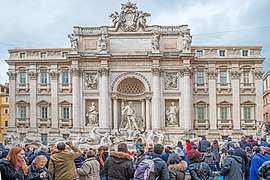 Trevi Fountain
Trevi Fountain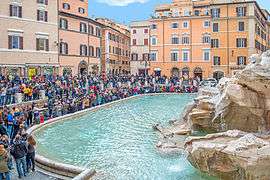 Trevi Fountain
Trevi Fountain
In popular culture
In 1973, the Italian national postal service dedicated a postage stamp to the Trevi Fountain.[17]
In The Lizzie McGuire Movie, Lizzie tossed a coin into the Trevi Fountain to wish for smooth sailing in her coming high school years.
See also
- List of fountains in Rome
- Fountains of Rome
References
- "Trevi Fountain". TreviFountain.net.
- Silver, Alexandra (17 May 2010). "Top 10 Iconic Movie Locations". Time. Time magazine. Retrieved 21 May 2018.
- Though other etymologies have been suggested, this is the straightforward modern etymology adopted by Pinto 1986 and others.
- The technical Italian term for such a "terminal fountain" is a ("display"): Peter J. Aicher, "Terminal Display Fountains ("Mostre") and the Aqueducts of Ancient Rome" Phoenix 47.4 (Winter 1993:339–352).
- Pinto, John A. (1986). The Trevi Fountain. New Haven: Yale University Press. p. 326. ISBN 0300033354.
- John A. Pinto, "An Early Project by Nicola Michetti for the Trevi Fountain" The Burlington Magazine 119 No. 897 (December 1977:853–857).
- Pinto, John; Elisabeth Kieven (December 1983). "An Early Project by Ferdinando Fuga for the Trevi Fountain in Rome". The Burlington Magazine. 125: 746–749, 751.
- Gross, Hanns (1990). Rome in the Age of Enlightenment: the Post-Tridentine syndrome and the ancient regime. New York: Cambridge University Press. p. 28. ISBN 0-521-37211-9.
- Delli, Sergio (1975). Le strade di Roma: una guida alfabetica alla storia, ai segreti, all'arte, al folklore [The streets of Rome: an alphabetic guide to history, secrets, art, folklore] (in Italian). Armando. Retrieved 21 May 2018.
- Andrieux, Maurice (1968). Rome. Funk & Wagnalls. Retrieved 21 May 2018.
- Minor, Vernon Hyde (1997). Passive Tranquillity: The Sculpture of Filippo Della Valle. American Philosophical Society. p. 252. ISBN 978-0871698759. Retrieved 21 May 2018.
- Marder, Tod A.; Jones, Mark Wilson (2015). The Pantheon: From Antiquity to the Present. Cambridge University Press. p. 523. ISBN 978-1316123232. Retrieved 21 May 2018.
- Powell, Lindsay (2015). Marcus Agrippa: Right-hand Man of Caesar Augustus. Pen and Sword. p. 198. ISBN 978-1473854017. Retrieved 21 May 2018.
- Rapagina, Luigi; Matarazzo, Massimiliano (2016). The Trevi Fountain: Digital travel guide. Edizioni Polìmata. p. 15. ISBN 978-8896760925. Retrieved 19 May 2018.
- "The Trevi Fountain – The most beautiful fountain in the world". Retrieved 23 February 2014.
- "Trevi Fountain Is To Have A Year-long Restoration". Chicago Tribune. New York Times News Service. 6 March 1988. Retrieved 21 May 2018.
- "The Trevi Fountain and the Dolce Vita!". Euronews. 3 November 2015. Retrieved 19 May 2018.
- Pullella, Philip (29 January 2013). "Rome Trevi Fountain, symbol of Dolce Vita, to get big facelift". Reuters. Retrieved 29 January 2013.
- "Torna l'acqua a Fontana di Trevi, dopo il restauro firmato Fendi". Roma – La Repubblica. 3 November 2015.
- "La Fontana di Trevi torna all'antico splendore dopo il restauro". rainews. 11 March 2015.
- "La Fontana di Trevi, applauso e flash salutano il ritorno dell'acqua". ANSA.it (in Italian). 4 November 2015. Retrieved 27 March 2019.
- "Trevi Fountain: Overall view of fountain with the facade of Palazzo Poli". CurateND. University of Notre Dame. 1 January 1910. Retrieved 20 May 2018.
- Pullella, Philip (23 January 2013). "Rome Trevi Fountain, symbol of Dolce Vita, to get big facelift". Reuters. Retrieved 20 May 2018.
- "Trevi Fountain". Lonely Planet. Retrieved 20 May 2018.
- Cox, Josie (13 April 2017). "Rome's Trevi Fountain generates €1.4m for city's charities in 2016, reports Caritas". The Independent. Retrieved 20 May 2018.
- "Trevi coins to fund food for poor". BBC News. 26 November 2006. Retrieved 18 January 2010.
- "Rome's Trevi Fountain Holds Nearly $1.5 Million in Loose Change". NBC. 13 April 2017.
- "Trevi coins row re-surfaces". BBC News. 8 October 2003. Retrieved 18 January 2010.
- "Trevi fountain 'copycat' thieves arrested". BBC News. 9 August 2002. Retrieved 18 January 2010.
External links
| Wikimedia Commons has media related to Trevi Fountain. |
| Wikisource has the text of the 1905 New International Encyclopedia article Fountain of Trevi. |
- Roman Bookshelf – Trevi Fountain – Views from the 18th and 19th centuries
- Trevi Fountain Virtual 360° panorama and photo gallery.
- Engraving of the fountain's more modest predecessor.